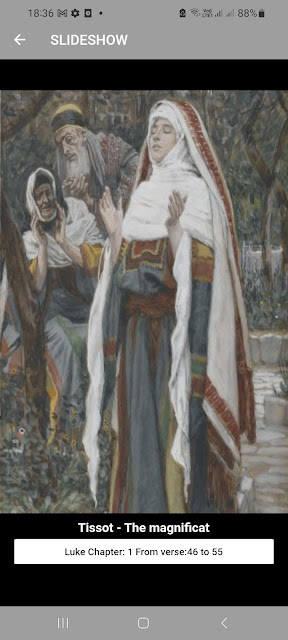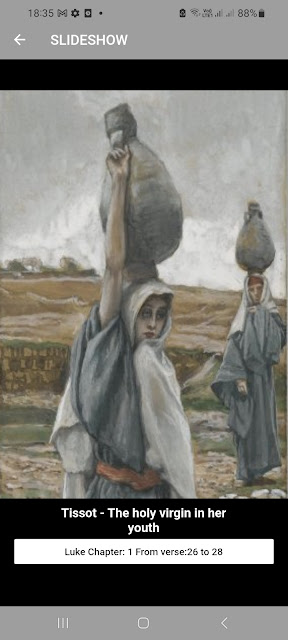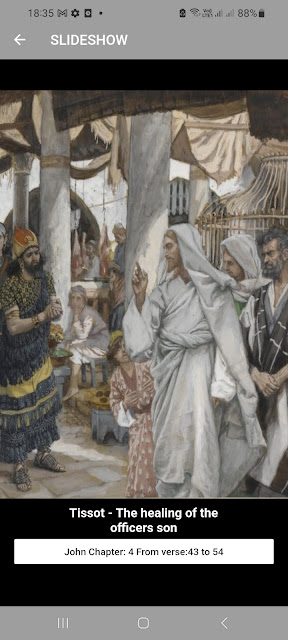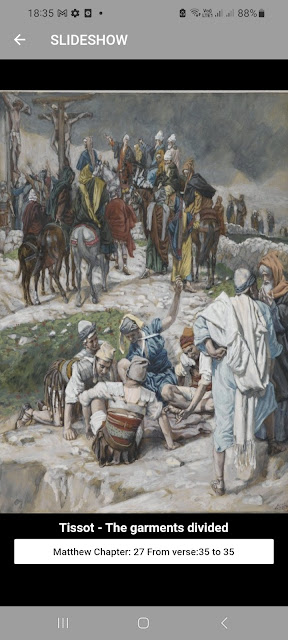Our Christian Background for phone app has about 1,000 bible paintings by master painters from the Renaissance period to more recent times. The paintings have been adjusted to allow them to serve as images for both iOS and Android devices, Feel free to explore more by going to our app as below.
a) Tissot The Magnificat Luke 1:46-55
The Magnificat is also called the Song of Mary. It is a hymn of praise and thanksgiving that Mary, the mother of Jesus, sang after visiting her cousin Elizabeth, who was also pregnant at the time.
Here is the text of the Magnificat:
"My soul magnifies the Lord,
and my spirit rejoices in God my Savior,
for he has looked with favour on the lowliness of his servant.
Surely, from now on all generations will call me blessed;
for the Mighty One has done great things for me,
and holy is his name.
His mercy is for those who fear him
from generation to generation.
He has shown strength with his arm;
he has scattered the proud in the thoughts of their hearts.
He has brought down the powerful from their thrones,
and lifted up the lowly;
he has filled the hungry with good things,
and sent the rich away empty.
He has helped his servant Israel,
in remembrance of his mercy,
according to the promise he made to our ancestors,
to Abraham and to his descendants forever."
The Magnificat is a powerful expression of Mary's faith in God's goodness and mercy, and her recognition that God has chosen her, a lowly servant, to play an important role in his plan of salvation.
b) Tissot Parable of The lost Drachma Luke 15:8-10
In the parable, a woman who has ten silver coins (drachmas) loses one of them. She searches her house carefully, sweeping every corner and looking under every piece of furniture until she finds the lost coin. When she finds it, she calls her friends and neighbours together to share her joy with them, saying, "Rejoice with me; I have found my lost coin!" This was no mean feat, as a drachma was the value of a day's work for the working classes; its loss was great indeed.
The parable is often interpreted as a metaphor for God's love and mercy towards sinners. Just as the woman in the story searches diligently for her lost coin, God seeks out and welcomes back those who have strayed from him. The parable also emphasizes the value of each individual in the eyes of God, and the importance of repentance and reconciliation with God and others.
c) Tissot The holy virgin in her youth
The painting is a depiction of Christ's crucifixion and subsequent removal of his body from the cross. In the gospel accounts, after He was crucified, his body was taken down from the cross by Joseph of Arimathea (who obtained permission to do so from Pontius Pilate) and Nicodemus, a Pharisee and member of the Sanhedrin who had come to believe in the Lord. They wrapped His body in linen cloth and placed it in a tomb, which was sealed with a large stone. At the cross, the gospels tell us that the women present were his mother and his mother's sister, Mary the wife of Clopas, and Mary of Magdala.
e) Tissot The parable of the hidden treasure
The parable goes like this:
"The kingdom of heaven is like treasure hidden in a field. When a man found it, he hid it again, and then in his joy went and sold all he had and bought that field.
Again, the kingdom of heaven is like a merchant looking for fine pearls. When he found one of great value, he went away and sold everything he had and bought it."
The meaning of the parable is that the kingdom of heaven is like a treasure that is hidden, but once it is found, it is worth giving up everything for. The Lord is teaching that there is nothing on earth that can compare to the Kingdom, and thus we should strive greatly to attain it.
f) Tissot The healing of the officer's son
A royal official came to the Lord and begged him to come and heal his son, who was near death. The Lord responded by telling the man, "Unless you people see signs and wonders, you will never believe" (John 4:48).
The official persisted, saying, "Sir, come down before my child dies" (John 4:49). Jesus then told him, "Go, your son will live" (John 4:50). As the official was on his way home, his servants met him and told him that his son was alive and well. When the man asked them at what time his son had recovered, they told him that it was the exact time when Jesus had said, "Your son will live" (John 4:53).
The allusion to "people seeing signs" is in exact contrast to the Centurion who went to Christ on the same issue, except it was for his servant. He didn't deem it necessary for Jesus to go to his home but rather asked him to say the word, and he was sure his servant would be healed. This is a true mark of faith; simply believing without needing to see a sign.
The story concludes by stating that the official and his entire household believed in the Lord as a result of this miraculous healing.
g) The healing of 10 lepers John 4:43-54
In Luke 17:11-19, Christ was on his way to Jerusalem and passed through the borderland between Samaria and Galilee, where he encountered a group of ten lepers who stood at a distance and called out to him for mercy (Jewish laws forbade lepers from mixing with the general population). Jesus told them to go and show themselves to the priests, which was the customary way of being declared clean from leprosy under the Mosaic law.
As the ten lepers obeyed and began to walk away, they were all healed of their leprosy. However, only one of them, a Samaritan, returned to Jesus, fell at his feet, and gave thanks to him. Christ marvelled at the man's gratitude, saying, "Rise and go; your faith has made you well."
This story demonstrates the power of Jesus to heal and the importance of gratitude and faith in receiving his blessings. It also highlights the fact that salvation and healing are available to all people, regardless of their social or ethnic background.
h) The garments divided Matt 27:35
In Matthew 27:35, it is recorded that after Christ was crucified, the Roman soldiers who were carrying out the execution divided his garments among themselves by casting lots. This was a common practice at the time, as the clothing of executed criminals became the property of the soldiers who carried out the execution.
The act of dividing the garments fulfilled a prophecy from Psalm 22:18, which says, "They divide my garments among them and cast lots for my clothing." This prophecy was seen as a foreshadowing of Jesus' crucifixion and was understood by early Christians as further evidence of his messiahship and the fulfilment of Old Testament prophecies.
The dividing of the garments also underscores the brutal and dehumanizing nature of crucifixion, which was a common form of execution in the Roman Empire. It was a painful and humiliating death, and the division of the victim's clothing among the executioners was one final indignity inflicted upon them.
i) Tissot The last shall be first Matt 20:16
In Matthew 20:16, Jesus makes a statement about the kingdom of heaven: "So the last will be first, and the first will be last." This statement follows a parable He tells about a landowner who hires workers for his vineyard throughout the day but pays them all the same wage at the end of the day.
The parable illustrates the generosity and grace of God, who rewards all who enter into his kingdom with the same gift of salvation, regardless of how long they have served him. It also highlights the danger of envy and resentment, as those who worked all day complained that they were paid the same wage as those who only worked for an hour.
The statement "the last will be first, and the first will be last" is a reminder that in the kingdom of heaven, worldly distinctions such as wealth, power, and status are of little importance. Instead, what matters is one's faith in God and obedience to his will. It is a call to humility and a reminder that the values of God's kingdom are often at odds with the values of the world.
As a personal caveat, I have always thought that indeed the bare minimum offered to all is salvation, however since it is a Kingdom one is entering, there will certainly be a distinction between the more and less pious. Only seems fair and right to me.
j) Tissot The first nail Matt 27:32-56
In Matthew 27:32-56, it is recorded that Jesus was crucified on a hill called Golgotha or the Place of the Skull. After being flogged and mocked by the Roman soldiers, he was forced to carry his own cross to the place of execution, but due to his weakened state, Simon of Cyrene was compelled to carry it for him.
Once they arrived at Golgotha, He was nailed to the cross by the Roman soldiers. The Bible does not specify which nail was used first, but it is clear that he was nailed through his hands and feet. This was a painful and humiliating form of execution that was reserved for the worst criminals.
As He hung on the cross, he was mocked by the religious leaders and passersby, but he also demonstrated his love and forgiveness by praying for his executioners and promising paradise to a criminal who was crucified next to him.
The crucifixion is a central event in Christian theology, as it is believed to have atoned for the sins of humanity and reconciled humanity with God. The nails that were used to crucify him have become a symbol of his sacrifice and the depth of his love for humanity.
Enjoy









